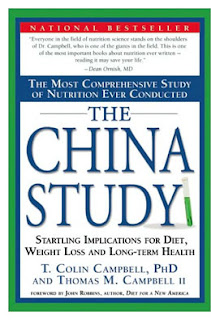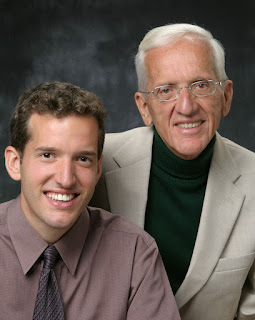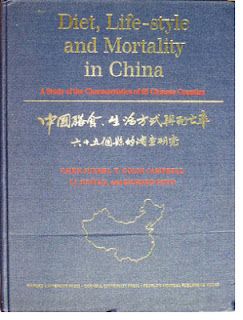Campbell, T. Colin, The China Study; Startling Implications for
Diet, Weight Loss and Long-term Health. Dallas, Texas: BenBella Books,
2006.
I recently finished reading the China Study: Startling Implications for Diet,
Weight Loss and Long-term Health by Dr. T. Colin Campbell and his son Dr. Tom Campbell. I
have been intrigued with the book for quite some time, however for some reason
the 400 page monograph seemed daunting. While still 400 pages, the book is a
distilled and truncated version of Dr. Campbell’s and Dr. Chen Junshi’s Diet, Life-style and Mortality in China
which clocks in at a massive 894 pages. The New
York Times called this study the “Grand Prix of
epidemiology" and the "most comprehensive large study ever undertaken
of the relationship between diet and the risk of developing disease."
This book is a powerhouse of
fair, balanced, and evidenced-based nutritional information, which makes the
book standout when it is placed among “diet” books on shelves in bookstores. Containing
nearly thirty pages of references and three appendixes with more detailed
information, the book is clearly the result of a lifetime (over forty years in
Campbell’s case) of research in nutrition.
Background:
T. Colin Campbell’s story is
interesting on its own and he includes a large part of his story in the final section
of the book. He grew up on a rural dairy farm. Perhaps ironically, his father
died quite young of heart disease. As the first in his family to attend
college, Campbell studied pre-veterinary
medicine at Pennsylvania State University. He
obtained his B.S. in 1956 and then attended veterinary school at the University of Georgia for a year. During that time he became increasingly
interested in the diets of humans, changed tracts, transferred to Cornell, and finished his Ph.D. under Clive McCay (a famous
researcher of diet and aging) in 1961. He then went to teach and research at MIT
and later Virginia Tech, but ultimately spent the majority of his career in the
nutrition sciences department of his alma mater, Cornell.
His early research focused on
malnutrition and protein, which brought him to Indonesia, to study diet and
lifestyle. While there he began to notice, that contrary to his then working
hypothesis, the more animal foods one ate, the more likely the person would
suffer from cancer. Up to this point, Campbell firmly believed malnutrition was the
result of a lack of animal protein from a persons diet. However he soon began
to question this hypothesis and the result dramatically altered his career.
Finally, while he was in Indonesia, Campbell read a small and obscure paper
published on cancer and animal protein in mice and rats, which observed that
cancer grew more rapidly when a diet contained higher levels of casein (the
main protein found in cheese and dairy products). Even more important, a diet
low in animal protein could stop and
even reverse the growth of cancer cells.
Campbell returned to the States
and recreated the experiment he read about. It amazed him. He then spent the
next thirty-five years furthering the field along this path while winning some
of the most prestigious awards for research along the way. However, his most
remarkable work remains the China Study.
The
Study
In the early 1970s, the
premier of China was diagnosed with terminal cancer. As a result, he ordered a
nationwide survey to collect information on the disease and its impact on the
Chinese population. Between 1973-75, the surveys were collected. It was a
monumental study of death rates for twelve different kinds of cancer for more
than 2,400 Chinese counties and 880 million (96%) of their citizens. The end
result was an atlas showing where certain types of cancer were high and where
they were almost nonexistent. The atlas made it clear that in China, cancer was
geographically localized. “Some cancers were much more common in some places
than in others.” This was significant because the variations existed within a
country where 87% of the population was of the same ethnic group, essentially
taking genes out of the equation of cancer risk. Because there was such a
massive variation in cancer rates among different counties where genetic
backgrounds were similar from place to place, it seemed possible that cancer
could be connected to environmental and lifestyle factors rather than genetics
(it is estimated that genetics determines only around 2-3% of the total cancer
risk- “Genes do not act in isolation; they need a trigger for their effects to
be produced”).
China
proved the perfect place to study cancer and lifestyle because “critical to the
importance of the China Study was the nature of the diet consumed in rural
China.” It was a rare opportunity to study health-related effects of a mostly
plant-based diet.
This sparked Dr. Campbell’s
interest and in 1983 an international team of biochemists and scientists were working
closely to find correlations between the
cancer atlas and a new, large collection of dietary surveys and blood work.
Between 1983-4, they collected data on 367 variables from 6,500 people living
in 65 different counties, and then compared each variable with every other
variable. The results were astonishing. They collected over 8,000 statistically
significant associations between lifestyle, diet and disease variables. Not
surprisingly, the more animal protein that was consumed, the greater the risk
for contracting a number of different diseases, including several different
types of cancer, heart disease and diabetes. They also compared Chinese
populations to American populations of similar activity levels and found that
on average the Chinese consumed 30% more calories based off body weight than
Americans and yet found their body weight was on average 20% lower.
While Dr. Campbell is very forthright about the fact that
“absolute” proof of causation is almost impossible in scientific studies, his
book leaves little doubt about the correlation between diet and disease. The
study emphasized a whole-food plant based diet while also eliminating all
meats, poultry, fish, eggs and dairy products (Dr. Campbell identifies dairy as one of the most potent carcinogens that humans are exposed to). They claim that eating a healthy
vegan diet will help one escape, reduce or even reverse the development of
chronic disease.
The
Actual Book
In this work, Dr. Campbell has set an ambitious goal: “I
propose to do nothing less than redefine what we think of as good nutrition.” The
book is divided into four sections, but for simplicity it can really be divided
into three parts.
The first section reviews some
of the ground I’ve already covered. Dr. Campbell’s transition towards and
advocacy for a plant based diet, his early work on mice, casein, and tumor
growth and the China study. Just from this section alone, Campbell builds a
compelling case linking the consumption of animal protein, cholesterol, and processed foods to increased cancer risks. However, in section two Campbell goes into
a detailed review of the peer-reviewed secondary literature dating back to the late 1800s, which demonstrates
how animal protein is linked to nearly every other major western disease (also know as diseases of affluence).
In this section, Dr. Campbell
and his son have done extremely diligent work. Each chapter relates to a
different major disease and how diet and nutrition can affect that disease.
These chapters include heart disease with an extended discussion of the work
from Dr. Esselstyn and Dr. John McDougall, obesity, diabetes as well as more
surprising chapters on autoimmune diseases, bone health, and kidney, eye and
brain diseases.
In each chapter, Campbell
discusses the newest research on the causes of these diseases. By this point in
the book, it is no surprise that animal products are intimately linked to each
one. For instance, it now seems the autoimmune disease known as Type 1
diabetes, previously thought to be a genetic issue, could actually be triggered
by exposing newborns to dairy milk (perhaps in infant formula) too early in
their lives. In fact a study done in Chile found that children weaned too early
onto cow’s milk-based formula had a 13.1 times greater risk of contracting the
disease. This is because most newborns are unable to fully digest the small
amino acid chains or fragments of the original protein found in milk and remain
in the intestines and absorbed into the blood. The immune system recognizes
these fragments as foreign invaders and goes about destroying them.
Unfortunately, some of these fragments look exactly the same as the cells of
the pancreas which makes insulin. As a result, the immune system will also
start attacking the cells of the pancreas and the body will no long be able to
produce insulin. The result is a devastating disease that the child will have to deal with for the remainder of its life.
The final section focuses on why this information isn’t more common spread. The answer is surprising obvious. Imagine for a second a newspaper headline about Cows
milk causing Type 1 diabetes? It would have a dramatic financial implication
for American agriculture. Obviously the entire food system would be greatly impacted. As a result there a barriers built into the system to help protect against that from happening. But is it a conspiracy? According to Dr. Campbell, no
it is not. Rather, he claims it is simply the powerful work of a few people
favoring the status quo over sound science.
Unfortunately, part of the
status quo means that the majority of nutritional information is filtered through
three different levels. First are the scientists, many of whom have close ties
to the food and drug industries as their departmental positions are funded in part by various
corporations, the result, according to Campbell, are nutritionists become less
interested in challenging a system which literally supports them. These scientists are also the most likely to be placed onto governmental committees as "experts" who are responsible for creating acceptable nutritional standards.
Second is
government. Perhaps the saddest of the trio, the government has consistently
put economic issues and corporate interests in front of protecting their
citizens’ health. This is evidenced every time a major governing body fills
committees with lobbyists rather than scientists or when lobbyists are
successful in their attempt to bury an honest report. Just think back to the most recent farm bill debate where tomato sauce ontop of pizza was defined as a vegetable and pink slime was found to be nutritionally acceptable.
Finally, Campbell points
his wagging finger at the corporations who fund most of the nations nutritional
research. These corporations are broad in their range as well as their
influence. Obviously, the meat, dairy and egg industries are powerful, but
Campbell also reminds his readers that the orange industry has been startlingly
successful at identifying their product with Vitamin C. Not only that, but drug
companies sponsor most medical schools in the nation.
One does not need to have
an overactive imagination to imagine what this trio has caused to those who
eat the Standard American Diet. Campbell claims this is one of the largest threats to America's future security as a nation, as healthcare spending dwarfs even the swollen military budgets yet the population becomes increasingly less healthy. Campbell’s theory is more than plausible as he
details his own personal struggles from within the scientific community. Indeed
it is often hard to believe his career was not squashed by these powers while
he was still in Indonesia.
The book details the struggles
that Dr. Caldwell Esselstyn and Dr. John McDougall faced as well. Dr. McDougall was
threatened with expulsion from his residency when he counseled a heart patient
with advice about nutrition. Dr. Esselstyn, a top surgen at
the Cleveland Clinic, was ostracized by his peers and his plea to help Cleveland’s medical school develop a
plant-based healing center have consistently been ignored. Still both have remain steadfast and have been able to help thousands of people heal themselves of heart disease and diabetes through diet.
It seems possible that some of
Campbell’s claims are the result of overreaching from the actual evidence;
after all, correlations are not causation. But its more likely that Campbell’s
work is really that definitive. Campbell prides himself on the fact that he is nothing
if not a careful and cautious scientist and while his book is written for a
general audience, in the three appendixes Campbell goes into further detail
about his protein studies in rats, his China Study, supplementations and
Vitamin D – all of which were highly provocative as well as useful. When one
considers the large amount of supporting secondary research Dr. Campbell relies
on, it becomes nearly impossible to ignore his findings.
While the book has had it’s
fair share of critics (many of which have been responded to personally by
Campbell), it has met the praise of some of the most serious researchers in the
field including Dr. Wilfred Niels Arnold
from the University of Kansas and Professor Hal Harris of the University of
Missouri–St. Louis who actually converted with his graduate students to a whole
food, plant-based diet after reading the book. CNN’s Sunjay Gupta claims the book had a similar impact on him in
his documentary called The Last Heart Attack. Campbell’s admirers also include President Bill
Clinton, Oprah, Dr. Oz and thousands of others around the world. It seems to me
that few others have had the impact on human health that Dr. Campbell has had
(or, ironically, for animal rights, something Dr. Campbell does not vocally
support). There are few books which can literally save your life, this is one
of them and it should not be ignored.






Great review!! Very thorough and a good read!
ReplyDeleteNice Post. I enjoyed it reading, it has some useful information on skin care.
ReplyDeleteWeight loss Dallas Texas